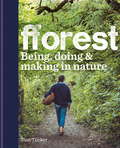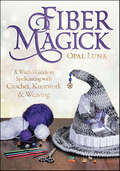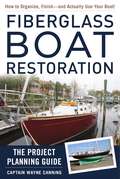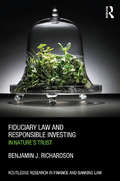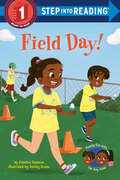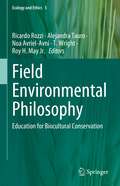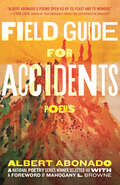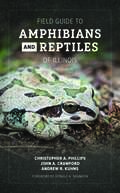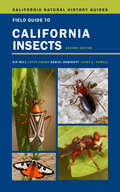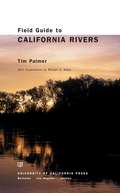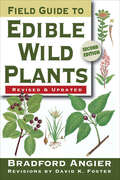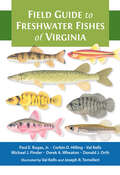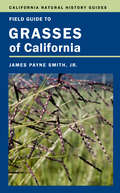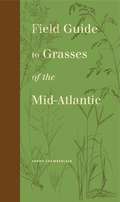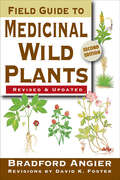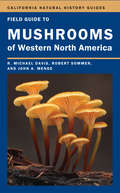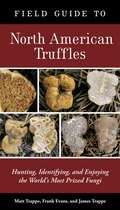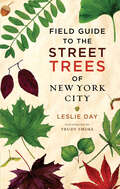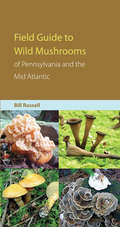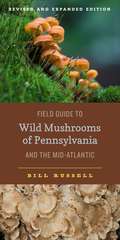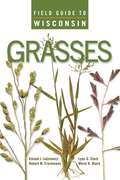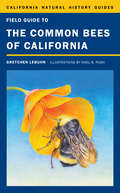- Table View
- List View
Fforest: Being, Doing & Making in Nature
by Sian TuckerCalming to the soul and good for us all, spending time outdoors offers us precious breathing space away from the stresses and strains of modern life. This inspirational guide celebrates the life enhancing effect of nature and encourages you to try the pursuits that would have been second nature to previous generations - from walking in the dark with only the light of the moon and stars to guide you, to wild swimming, forest bathing and sleeping under canvas. It will inspire you to re-discover the joy of sky and clouds, night and tides, stars and silence. <P><P>Photography by Finn Beales
Fiber Magick: A Witch's Guide to Spellcasting with Crochet, Knotwork & Weaving
by Opal Luna70+ Craft Projects to Spark Your Imagination & Enhance Your Magick Featuring over 100 color photos and illustrations, this fun and accessible guide introduces you to the magickal power of crochet, knotwork, and other fiber crafts. Witch and crochet expert Opal Luna shows you how to move spiritual intention from your mind into your hands through practical exercises, creative techniques, and patterns for more than seventy projects.Improving your magick through fiber arts is easy with Opal's step-by-step instructions and empowering guidance. Discover the tools of the trade, the power of color, and a variety of weaving, braiding, and knotting methods. Learn how to connect to deities and create sacred space for your practice. Explore how Fiber Magick can be used in your holiday celebrations and rites of passage. From sigils and yarn amulets to prayer shawls and crocheted poppets, Fiber Magick is full of delightful projects and perfect for practitioners of all skill levels.
Fiberglass Boat Restoration: The Project Planning Guide
by Captain Wayne CanningHow to select a boat, plan your project, finish the job, and actually head for the water.Over the past thirty to forty years boat builders, large and small, have produced tens of thousands of fiberglass boats. Many now sit abandoned, waiting for some tender care to get back on the water where they belong. Fiberglass unlike many other types of boatbuilding materials does not rot, rust, or break down over the years. Many people have realized this, of course, and have started what they think will be an easy project. They were wrong, and many well-intentioned renovations sit abandoned.Whatever the reason for wanting to take on the restoration of a project boat, proper planning and organization can make the difference between success and failure. Fiberglass Boat Restoration is about how to plan, organize and successfully complete a project boat restoration. It will explain why it is important to put your efforts and resources into some areas and not others. It contains valuable information about what to look for when considering the purchase of a project boat. Although the focus of the book is fiberglass, the information will be useful to anyone undertaking the building or restoration of any boat.
Fiduciary Law and Responsible Investing: In Nature’s trust (Routledge Research in Finance and Banking Law)
by Benjamin J. RichardsonThis book is about fiduciary law’s influence on the financial economy’s environmental performance, focusing on how the law affects responsible investing and considering possible legal reforms to shift financial markets closer towards sustainability. Fiduciary law governs how trustees, fund managers or other custodians administer the investment portfolios owned by beneficiaries. Written for a diverse audience, not just legal scholars, the book examines in a multi-jurisdictional context an array of philosophical, institutional and economic issues that have shaped the movement for responsible investing and its legal framework. Fiduciary law has acquired greater influence in the financial economy in tandem with the extraordinary recent growth of institutional funds such as pension plans and insurance company portfolios. While the fiduciary prejudice against responsible investing has somewhat waned in recent years, owing mainly to reinterpretations of fiduciary and trust law, significant barriers remain. This book advances the notion of ‘nature’s trust’ to metaphorically signal how fiduciary responsibility should accommodate society’s dependence on long-term environmental well-being. Financial institutions, managing vast investment portfolios on behalf of millions of beneficiaries, should manage those investments with regard to the broader social interest in sustaining ecological health. Even for their own financial self-interest, investors over the long-term should benefit from maintaining nature’s capital. We should expect everyone to act in nature’s trust, from individual funds to market regulators. The ancient public trust doctrine could be refashioned for stimulating this change, and sovereign wealth funds should take the lead in pioneering best practices for environmentally responsible investing.
Field Day! (Step into Reading)
by Candice RansomGet ready for some outdoor fun in this Step 1 book that's perfect for readers ages 4-6! Join the Day kids as they gear up for field day at school.What's more fun than field day? The Day kids are so excited! They gobble their breakfast and race to the bus. So many fun things are waiting for them! Spoon-and-egg race! Face-painting! Kickball! A bouncy castle! Brother and sister can't wait! Step 1 Readers feature big type and easy words. Rhymes and rhythmic text paired with picture clues help children decode the story. For children who know the alphabet and are eager to begin reading.A day with family is always a great day! Read all the DAY family books:Apple Picking Day!Pumpkin Day!Garden Day!Beach Day!School Day!
Field Environmental Philosophy: Education for Biocultural Conservation (Ecology and Ethics #5)
by Ricardo Rozzi Roy H. May T. Wright Alejandra Tauro Noa Avriel-AvniThis fifth volume in the Ecology and Ethics series integrates key concepts of the previous four volumes by addressing biocultural conservation through novel educational methods. In Field Environmental Philosophy (FEP), the authors undertake two complementary tasks. First, they address a problematic facet of education as an indirect driver of a global change and biocultural homogenization. Second, they contribute to solve the former problems by introducing the FEP method as well as other educational approaches from around the world that value and foster conservation of biological and cultural diversity. A particular emphasis is therefore on the integration of sciences, arts, humanities, and ethics into educational practices that involve the participation of local communities with their diverse forms of ecological knowledge and practices. The book is divided into four parts. Part I introduces FEP concepts and practices that involve a 4-step cycle of transdisciplinary research, poetic communication through composition of metaphors, design of field activities guided with an ecological and ethical orientation, and participation in biocultural conservation activities. Part II exposes problems as well as solutions in formal education (from preschool to higher education) and non-formal education to respect biocultural diversity. Parts III & IV provide case studies developed at long-term socio-ecological research (LTSER) sites, botanical gardens, and other platforms for non-formal education that contribute to biocultural conservation.This book supports a paradigm shift addressing still understudied indirect drivers of global change to foster the conservation of biological and cultural diversity. It is a valuable asset for scientists and practitioners in science and humanities education.
Field Guide for Accidents: Poems (National Poetry Series #9)
by Albert AbonadoSELECTED BY MAHOGANY L. BROWNE FOR THE NATIONAL POETRY SERIESAn irreverent poetry collection that wrestles with questions of family, mortality, cultural history, and identity from the Filipinx-American experience "you showed him your teeth, you dared him to look into your mouth to see the metal bands straightening your jaw into an American smile."—from Field Guide for AccidentsBorn in the United States to Filipino immigrants, poet Albert Abonado is no stranger to the language of periphery. Neither wholly &“American&” nor Filipino, Field Guide for Accidents&’s speakers are defined by what they are not: not white enough to be born in America, not Asian enough to feel at home in the Philippines. Abonado&’s poetry illuminates the strange and surreal in domestic routine, suturing wounds of love, grief, and the contradiction of being Filipinx-American, two identities bound with a hyphen that resists negation. What results is a growing exposure to a world mired in paradox.The poems in Field Guide for Accidents experiment with the constraints of the poetic line, shaping forms that exhume what tend to haunt us in the silence. In Field Guide for Accidents, memory becomes augmented with the imaginary; suspicion collides with superstition, while spirituality crosses paths with scientific fact. A mother returns to her son as a boat. A stew is prepared with blood yet masked as chocolate. The living eat with the dead in memories built like houses. Mythic, bloodthirsty creatures in Pinoy folklore prey on an exhausted poet. Research conducted in hindsight provides new avenues to explore regret.For many third-culture kids of the Asian-American diaspora, there is no such thing as a success story for &“fitting in.&” What matters more is finding where you belong. Spooning images from hand to mouth, the poems in Field Guide for Accidents struggle with what it means to consume and be consumed by American culture.
Field Guide to Amphibians and Reptiles of Illinois
by Christopher A. Phillips John A. Crawford Andrew R. KuhnsThe second edition of the Field Guide to Amphibians and Reptiles of Illinois offers up-to-date information on the state’s 102 species of frogs and toads, salamanders, turtles, lizards, and snakes. Detailed descriptions by the authors include habitats, distinguishing features, behaviors, and other facts, while revised range maps and full-color photographs help users recognize animals in the field. In addition, an identification key and easy-to-navigate page layouts guide readers through extensive background material on each species' population, diet, predators, reproduction, and conservation status. A one-of-a-kind resource, the Field Guide to Amphibians and Reptiles of Illinois is a definitive guide aimed at biologists, teachers, students, wildlife specialists, natural resource managers, conservationists, law enforcement officials, landowners, hobbyists, and everyone else eager to explore herpetology and nature in the Prairie State.
Field Guide to California Insects: Second Edition (California Natural History Guides #111)
by Kip WillBeautifully illustrated and approachable, this is the only California-specific, statewide book devoted to all groups of insects. Completely revised for the first time in over 40 years, Field Guide to California Insects now includes over 600 insect species, each beautifully illustrated with color photographs. Engaging accounts focus on distinguishing features, remarkable aspects of biology, and geographical distribution in the state. An accessible and compact introduction to identifying, understanding, and appreciating these often unfamiliar and fascinating creatures, this guide covers insects that readers are likely to encounter in homes and natural areas, cities and suburbs, rural lands and wilderness. It also addresses exotic and invasive species and their impact on native plants and animals. Field Guide to California Insects remains the definitive portable reference and a captivating read for beginners as well as avid naturalists.
Field Guide to California Rivers
by Tim PalmerAward-winning author, naturalist, and conservationist Tim Palmer presents the world of California rivers in this practical and inspiring field guide. Loaded with tips on where to hike, fish, canoe, kayak, and raft, it offers an interpretive approach that reveals geology, plant and wild life, hydrologic processes, and other natural phenomena. Palmer reports on conservation with a perspective from decades of personal engagement. More than 150 streams are featured, 50 riparian species are illustrated, and 180 photos show the essence of California's rivers. Palmer brings a natural history guide, a recreation guide, and an introduction to river ecology together in one illuminating volume; it belongs in every river lover's book collection, boat, and backpack.
Field Guide to Edible Wild Plants
by Bradford AngierRevised and updated: The classic illustrated reference for today&’s foragers. With essential information on each plant&’s characteristics, distribution, and edibility, as well as updated taxonomy and eighteen new species, this is the second edition of Field Guide to Edible Wild Plants—the practical handbook for finding, preparing, and eating plants growing in the wild. This guide to North American wild edibles has been a nature classic for over thirty years. Now David K. Foster revises Bradford Angier&’s invaluable foraging reference. Scientific information for a general audience and full-color illustrations combine with intriguing accounts of the plants&’ uses, making this a practical and informative resource for modern-day foragers.
Field Guide to Freshwater Fishes of Virginia
by Corbin D. Hilling Valerie A. Kells Michael J. Pinder Derek A. Wheaton Paul E. Bugas Jr. Donald J. OrthA beautifully illustrated guide to the diverse and numerous freshwater fish species in Virginia.In Field Guide to Freshwater Fishes of Virginia, the foremost experts on Commonwealth fishes bring their decades of field experience to readers, offering a complete reference to the fishes of the entire state of Virginia. Gathering information that until now could only be found scattered across numerous reference works and online databases, this book provides everything you need to know to identify fish families and species in the Virginia region. Covering how to collect, handle, observe, conserve, and protect these unique fishes, the book's key features include • more than 175 vibrant, full-color illustrations, set side by side with descriptions of each fish• helpful line drawings that depict the most reliable diagnostic characteristics for field identifications (e.g., snout shape, pigment patterns, mouth morphology)• descriptions of Virginia's freshwater habitats • examples of incredible fish spawning and feeding behavior• tips on observing fish in the wild and in captivity• a chapter on the taxonomy of family and common names of the fish species most common throughout Virginia• up-to-date fish distribution maps• a complete glossary of termsProviding a fascinating foray into the wonders of the Commonwealth's swimmers, Field Guide to Freshwater Fishes of Virginia will appeal to scientists, naturalists, teachers, native fish aquarists, students, anglers, and fish collectors.
Field Guide to Grasses of California
by James P. Smith Jr.Grasses and grasslands are of increasing interest to conservationists, biologists, and gardeners. There are more than 300 species of native California grasses and they are found in almost every climate--from cool, wet forests to hot, dry deserts. Native grasses are also important to land restoration as they improve soil quality, increase water infiltration, and recycle nutrients. Their deep roots can tap soil water, which allows them to stay green year-round and to act as fire buffers around residences. Native grasses also provide vital habitat for many species of insects, birds, reptiles, and mammals. Despite their importance, grasslands remain one of the most underprotected of California's vegetation types, and native grasslands have undergone the greatest percentage loss of any habitat type in the state. Grasses are also among the most difficult plants to identify. Organized alphabetically, Field Guide to Grasses of California covers common native and naturalized grasses and, to help identify them, also features over 180 color illustrations.
Field Guide to Grasses of the Mid-Atlantic (Keystone Books)
by Sarah ChamberlainGrasses are among the most ubiquitous plants on the planet. They inhabit a wide geographic range and are found in a variety of natural habitats. The small parts of the grass flower and specialized terminology, however, can make identifying grasses a challenging endeavor. Sarah Chamberlain’s Field Guide to Grasses of the Mid-Atlantic makes identification simpler for everyone—regardless of their previous botanical knowledge.Featuring an easy-to-use dichotomous key, this is a user-friendly guide to more than 300 types of grasses found from the Blue Ridge Mountains and southern plains to the Appalachians and the Allegheny Plateau. Each major entry contains detailed species diagrams as well as common names, habitats, and distribution. The book’s opening sections outline the parts of grass flowers and describe stem, leaf, and sheath characteristics.With a wealth of illustrations, instructions on how to use the key, and a glossary of terms, Field Guide to Grasses of the Mid-Atlantic is an indispensable reference for naturalists and conservationists, botanists, land management professionals, and students and scholars of mid-Atlantic flora.
Field Guide to Grasses of the Mid-Atlantic (Keystone Books)
by Sarah ChamberlainGrasses are among the most ubiquitous plants on the planet. They inhabit a wide geographic range and are found in a variety of natural habitats. The small parts of the grass flower and specialized terminology, however, can make identifying grasses a challenging endeavor. Sarah Chamberlain’s Field Guide to Grasses of the Mid-Atlantic makes identification simpler for everyone—regardless of their previous botanical knowledge.Featuring an easy-to-use dichotomous key, this is a user-friendly guide to more than 300 types of grasses found from the Blue Ridge Mountains and southern plains to the Appalachians and the Allegheny Plateau. Each major entry contains detailed species diagrams as well as common names, habitats, and distribution. The book’s opening sections outline the parts of grass flowers and describe stem, leaf, and sheath characteristics.With a wealth of illustrations, instructions on how to use the key, and a glossary of terms, Field Guide to Grasses of the Mid-Atlantic is an indispensable reference for naturalists and conservationists, botanists, land management professionals, and students and scholars of mid-Atlantic flora.
Field Guide to Medicinal Wild Plants
by Bradford AngierA revision of the definitive reference, containing plant characteristics, distribution, and medicinal qualities, an updated taxonomy, and fifteen new species. The Field Guide to Medicinal Wild Plants is the ultimate handbook for identifying and using wild plants for medicinal purposes. This illustrated guide to North American wild medicinals has been a nature classic for over thirty years. In this second edition, David K. Foster revises Bradford Angier's invaluable reference, updating the taxonomy and adding more than a dozen species, including the purple coneflower, popularly known as echinacea, as well as ephedra, jewelweed, goldenseal, and more. Scientific information for a general audience and full-color illustrations combine with intriguing accounts of the plants&’ uses, making this a practical guide for anyone interested in the medicinal uses of wild plants.
Field Guide to Mushrooms of Western North America
by R. Michael Davis John A. Menge Robert SommerCalifornia and the Western States are rich in abundant and diverse species of mushrooms. Amateur mushroom collectors and mycologists alike will find over 300 species of the region's most common, distinctive, and ecologically important mushrooms profiled in this comprehensive field guide. It provides the most up-to-date science on the role of fungi in the natural world, methods to identify species, and locations of mushroom habitats. With excellent color illustrations showing top and side views of mushrooms of the Western States and a user-friendly text, it is informative but still light enough to be carried into the woods. When used to identify mushrooms, keys bring the reader to individual species, with a descriptive text providing cues for identifying additional species. Mushrooms common in urban landscapes are included, which is especially useful for the casual encounter with backyard fungi. The guide also provides a table of both old and new species names, and information on edibility and look-alikes, both dangerous and benign. A section on mushroom arts and crafts features mushroom photography, painting, philately, spore prints, dyes, and cultivation. The guide also offers a comprehensive list of resources including national field guides, general mushroom books and periodicals, club and society contact information, and web sites. · Primary descriptions and illustrations of 300 species of mushrooms plus text descriptions of many more. · Latest word in mushroom taxonomy and nomenclature. Clear discussion of DNA sequencing and new classifications. · Especially good coverage of southern California and Southwestern mushrooms often neglected in other field guides.
Field Guide to North American Truffles: Hunting, Identifying, and Enjoying the World's Most Prized Fungi
by James M. Trappe Frank Evans Matt TrappeThe second most expensive food in the world after saffron, truffles are treasured, coveted, and savored for their mysterious and exotic flavor. This complete field guide shows chefs and fungi aficionados how to forage for and identify the wide variety of truffles that grow in temperate forests throughout North America. Written by expert horticulturalists who have studied, classified, and enjoyed truffles for decades, the FIELD GUIDE TO NORTH AMERICAN TRUFFLES makes these celebrated underground jewels accessible to all. The first full-color illustrated guide to identifying North American truffles by their key features, including profiles of more than 80 species of truffles. Includes more than 80 photographs of rare and hard-to-find truffle species. Features flavor profiles, delectability index, and culinary tips for each species. Perfect size for carrying in a pocket or daypack.Reviews"It'¬?s the first book of its kind, complete with photographs, cross-sectional views of indigenous truffle varieties, guides to seasonal availability, and foraging tips for hundreds of kinds of truffles (both the edible and inedible kinds), as well as tasting notes and cooking tips."-SaveurFrom the Trade Paperback edition.
Field Guide to Street Trees New York City
by Leslie Day“A handbook for naturalists, sidewalk denizens, apartment dwellers, dog-walkers, and bicycle riders . . . No New Yorker should be without this book.” —Wayne Cahilly, New York Botanical GardenNew York City is an urban oasis with hundreds of thousands of trees, and this guide acquaints residents and visitors alike with fifty species commonly found in the neighborhoods where people live, work, and travel. Beautiful, original drawings of leaves and stunning photographs of bark, fruit, flower, and twig accompany informative descriptions of each species. Detailed maps of the five boroughs identify all of the city’s neighborhoods, and specific addresses pinpoint where to find a good example of each tree species.Trees provide invaluable benefits to the Big Apple: they reduce the rate of respiratory disease, increase property values, cool homes and sidewalks in the summer, block the harsh winds of winter, clean the air, absorb storm water runoff, and provide habitat and food for the city’s wildlife. Bald cypress, swamp oak, silver linden, and all of New York’s most common trees are just a page turn away. Your evening walk will never be the same once you come to know the quiet giants that line the city’s streets.
Field Guide to Trees: Eastern Region
by National Audubon SocietyThe most comprehensive field guide available to the trees of North America's eastern region--a must-have for any enthusiast's day pack or home library--from the go-to reference source for over 18 million nature lovers. <p><p>Nearly 700 species of trees are detailed in beautiful, full-color photographs of leaf shape, bark, flowers, fruit, and fall leaves, and accompanied by informative text. Both compact and comprehensive, this is the ideal companion for beginner and advanced tree-peepers alike. Note: the Eastern Edition generally covers states east of the Rocky Mountains, while the Western Edition covers the Rocky Mountain range and all the states to the west of it.
Field Guide to Wild Mushrooms of Pennsylvania and the Mid-Atlantic (Keystone Books)
by Bill RussellTo most Americans, mushrooms are the brown lumps in the soup one uses to make a tuna casserole, but to a select few, mushrooms are the abundant yet often well-hidden delicacies of the forests. In spite of their rather dismal reputation, most wild mushrooms are both edible and delicious, when prepared properly. From the morel to the chanterelle and the prolific and aptly named chicken of the woods, mushrooms can easily be harvested and enjoyed, if you know where to look and what to look for. Bill Russell’s Field Guide to the Wild Mushrooms of Pennsylvania and the Mid-Atlantic helps the reader learn just that—specifically for the often-neglected East Coast mushrooms of the United States and Canada.Suited to both the novice and the experienced mushroom hunter, this book helps the reader identify mushrooms with the use of illustrations, descriptions, and environmental observations. Russell’s fifty years of experience in hunting, studying, and teaching about wild mushrooms have been carefully distilled into this easy-to-use and well-designed guide. The book is divided into the four seasons, each with its unique mushroom offerings. Each mushroom section includes a detailed description, information about the mushroom’s biology, tips on where the mushroom is most likely to be found, and a short “nutshell” description for quick reference. The book also includes color photographs of each of the mushrooms described.Russell’s Field Guide to the Wild Mushrooms of Pennsylvania and the Mid-Atlantic shows the reader not only how to identify the most common mushrooms found in the region but also how to avoid common copycats—and what to do with the mushrooms once they’re identified and harvested. With both color illustrations and insightful descriptions of one hundred of the area’s most common mushrooms, Field Guide is an indispensable reference for the curious hiker, the amateur biologist, or the adventurous chef.
Field Guide to Wild Mushrooms of Pennsylvania and the Mid-Atlantic: Revised and Expanded Edition (Keystone Books)
by Bill RussellThis revised and expanded edition of mushroom expert Bill Russell’s popular Field Guide to Wild Mushrooms of Pennsylvania and the Mid-Atlantic provides both novice and experienced mushroom foragers with detailed, easy-to-use information about more than one hundred species of these fungi, including twenty-five varieties not found in the previous guide.From the Morel to the Chanterelle to the aptly named Chicken of the Woods, mushrooms of the mid-Atlantic region can be harvested and enjoyed, if you know where to look. Each entry in this field guide contains a detailed description, current scientific classification, key updates and information from recent studies, and high-quality color photographs to aid in identification. Thoughtfully organized by season, the guide shows you how to locate and identify the most common mushrooms in the region and recognize look-alikes—and explains what to do with edible mushrooms once you’ve found them.Featuring over one hundred full-color illustrations and distilling Russell’s fifty years of experience in hunting, studying, and teaching about wild mushrooms, Field Guide to Wild Mushrooms of Pennsylvania and the Mid-Atlantic is an indispensable reference for curious hikers, amateur biologists, adventurous chefs, and mycophiles of all stripes.
Field Guide to Wild Mushrooms of Pennsylvania and the Mid-Atlantic: Revised and Expanded Edition (Keystone Books)
by Bill RussellThis revised and expanded edition of mushroom expert Bill Russell’s popular Field Guide to Wild Mushrooms of Pennsylvania and the Mid-Atlantic provides both novice and experienced mushroom foragers with detailed, easy-to-use information about more than one hundred species of these fungi, including twenty-five varieties not found in the previous guide.From the Morel to the Chanterelle to the aptly named Chicken of the Woods, mushrooms of the mid-Atlantic region can be harvested and enjoyed, if you know where to look. Each entry in this field guide contains a detailed description, current scientific classification, key updates and information from recent studies, and high-quality color photographs to aid in identification. Thoughtfully organized by season, the guide shows you how to locate and identify the most common mushrooms in the region and recognize look-alikes—and explains what to do with edible mushrooms once you’ve found them.Featuring over one hundred full-color illustrations and distilling Russell’s fifty years of experience in hunting, studying, and teaching about wild mushrooms, Field Guide to Wild Mushrooms of Pennsylvania and the Mid-Atlantic is an indispensable reference for curious hikers, amateur biologists, adventurous chefs, and mycophiles of all stripes.
Field Guide to Wisconsin Grasses
by Lynn G. Clark Emmet J. Judziewicz Robert W. Freckmann Merel R. BlackGrasses are the foremost plant family of prairies, savannas, barrens, many agricultural landscapes, lawns, and successional habitats throughout Wisconsin, yet they are notoriously difficult to identify. This field guide to 232 species of Wisconsin grasses includes more than 1,100 illustrations. Setting a new standard as the first new, illustrated midwestern grass identification manual to appear since the 1960s, it provides up-to-date, comprehensive information for naturalists, gardeners, landscapers, nursery horticulturalists, community restoration professionals, agronomists and biologists, and any outdoors lover. The book includes: #149; species descriptions and distribution maps for all 232 species #149; more than 700 color photographs accompanying species descriptions #149; drawings of most species #149; chapters on grass morphology and grasses in natural communities #149; keys to all species, including an illustrated key to genera #149; a glossary of grass terminology.
Field Guide to the Common Bees of California
by Gretchen LebuhnThis engaging and easy-to-use natural history guidebook provides a thorough overview of native and honey bee biology and offers tools for identifying the most common bees of California and the Western United States. Full-color illustrations introduce readers to more than 30 genera of native bees, noting each one's needs and habits and placing them in their wider context. The author highlights bees' ties to our own lives, the food we eat, and the habitat we provide, and suggests ways to support bees in our own backyards. In addition to helping readers understand and distinguish among major groups of bees, this guide reveals how bees are an essential part of healthy ecosystem and how many plants, including important crop plants, depend on the pollination they provide. As growing evidence points to declining bee populations, this book offers critical information about the bond between plants and pollinators, and between humans and nature. Thoroughly researched and full of new insights into the ancient process of pollination, Field Guide to the Common Bees of California; Including Bees of the Western United States is invaluable for the window it opens onto the biodiversity, adaptive range, and complexity of invertebrate communities.
